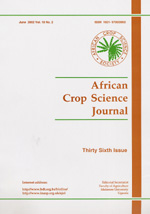
|
African Crop Science Journal
African Crop Science Society
ISSN: 1021-9730
EISSN: 1021-9730
Vol. 5, No. 1, 1997, pp. 87-92
|
 Bioline Code: cs97011
Bioline Code: cs97011
Full paper language: English
Document type: Short Communication
Document available free of charge
|
|
|
African Crop Science Journal, Vol. 5, No. 1, 1997, pp. 87-92
| fr |
Tenywa, J.S.
Résumé
Le molybdene (Mo) et le Cobalt (Co) sont des micro-elements importants pour
la fixation d'azote biologique. L'Ouganda mene une campagne pour elever la
productivite des legumes en utilisant des inoculations Rhizobiales, mais
souvent sans succes. Parmi les raisons possible, on a de quantites
insuffisantes de Mo et Co dans le sol. Pour examiner cette relation, une
etude a ete conduite dans la serre avec un Oxisol. On utilisait des
concentrations sub-normales de la chaux, Mo et Co. Le soya (Glycine max
Maerril), cultivar NAM.1 etait teste. L'application de 454 g/ha de Co
resultait en une nodulation elevee et une augmentation du nombre de nodules
effectives par plante, mais aussi dans l'accumulation d'azote totale.
L'application de la chaux diminuait l'acidite du sol avec 0.2 unites de pH.
Une combinaison de chaux (1 t CaCO3/ha) et Co (454g/ha) augmente la
nodulation et le nombre de nodules effectives par plante, mais masquait
l'effet positive de l'accumulation de l'azote totale dans les pousses.
L'application uniquement de la chaux n'influencait pas les indicateurs de
fixation biologique N dans cette etude.
Mots Clés
la fixation d'azote biologique, inoculation, chauler, le soya
|
| |
| en |
Influence of molybdenum and cobalt fertilisation on symbiotic nitrogen fixation indicators in an oxisol in Uganda
Tenywa, J.S.
Abstract
Molybdenum (Mo) and cobalt (Co) are important micro-elements involved in
biological N2-fixation. Uganda has embarked on a campaign to increase the
productivity of legume crops through utilisation of rhizobial inoculants,
unfortunately, non-responsiveness is frequently encountered. Among the
suspected causes are inadequacies of Mo and Co supply in the soil. A
glasshouse study was, therefore, conducted with an Oxisol to examine this
relationship. Treatments included provision of lime at 0 and 1.0 t ha-1,
Mo at 0, 390 and 780 g ha-1 and Co at 0, 454 and 907 g ha-1. Soybean
(Glycine max Merrill) cultivar NAM.1 was the test crop. Cobalt application
at a rate of 454 g ha-1 resulted in the greatest nodulation and number of
effective nodules per plant, as well as total N accumulation in the shoots.
Liming depressed soil solution acidity by 0.2 pH units. A combination of
lime (1 t CaCO3 ha-1) and Co (454 g ha-1) increased nodulation and the
number of effective nodules per plant, but masked cobalt's positive effect
on total N accumulation in shoots. Liming alone did not affect the
biological N fixation indicators considered in this study.
Keywords
Biological nitrogen fixation, inoculation, liming, soybean
|
| |
© Copyright 1997 - African Crop Science Society
|
|
